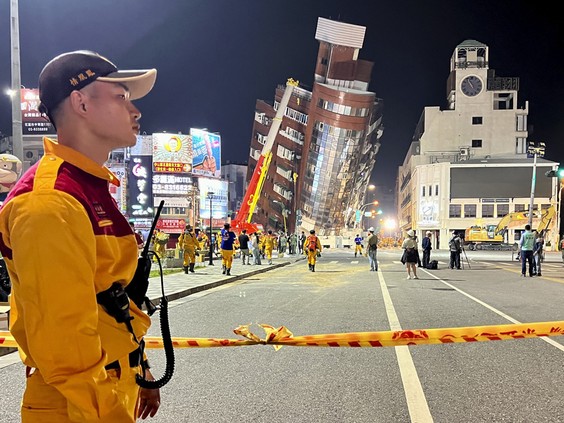
How Taiwan weathered a major earthquake with few deaths
The comparatively low death toll stands in stark contrast with the damage wrought by earthquakes in other countries, even in highly developed nations
 |
| A rescue worker stands near the cordoned off site of a damaged building in the aftermath of an earthquake in Hualien, Taiwan, April 3, 2024. PHOTO BY JOHNSON LAI/AP |
Tyler Dawson, Apr 03, 2024 : Taiwan was struck by a 7.4-magnitude earthquake on Wednesday — the most powerful to hit the island in a quarter-century.
Despite damage to homes and infrastructure, just nine people were killed, according to early reports, although hundreds were injured. This comparatively low death toll stands in stark contrast with the damage wrought by earthquakes in other countries, even in highly developed nations.
In 2011, an earthquake hit Christchurch, New Zealand, killing 165 people. Earthquakes in Nepal in 2015 killed nearly 10,000 people. A catastrophically destructive earthquake in Pakistan in 2005 killed nearly 90,000 people and the 2010 earthquake that hit the island of Hispaniola — which is shared by Haiti and the Dominican Republic — killed up to 300,000 Haitians.
“Taiwan’s earthquake preparedness is among the most advanced in the world,” said Stephen Gao, a seismologist and professor at Missouri University of Science and Technology. “The island has implemented strict building codes, a world-class seismological network, and widespread public education campaigns on earthquake safety.”
Photos and videos show buildings leaning at improbable angles in Hualien, a city in eastern Taiwan. The buildings hang out over the streets, surrounded by some rubble, but otherwise still intact, while cranes and rescue workers circle. In some cases, air conditioners can still be seen affixed to windows and many windows are still intact.
 |
| People gather in the lobby of an office building in Taipei, after a major earthquake hit Taiwan on April 3, 2024. PHOTO BY CNA/AFP VIA GETTY IMAGES |
These, said Christie Rowe, the Canada Research Chair in earthquake geology at Montreal’s McGill University, are likely cases of what’s known as “soft-storey collapse.”
“(They are) one of the most common types of building failures in earthquakes and often means total loss of the building,” Rowe wrote in an email.
While Taiwan restricted soft-storey designs after a devastating 1999 earthquake, these were perhaps older buildings that lacked strengthened ground floors. But, because the rest of the building structure was tough enough, even with the soft-storey collapse, the frame of the building remains intact.
A steel-framed building, even if the ground-floor collapses, can remain strong enough to stay mostly upright. In comparison, Rowe pointed to a building made of brick or stone, which would just rattle apart.
Basically three factors determine how damaging an earthquake will be. The first is the seismic magnitude, the amount of energy released by an earthquake. The 2010 Haiti earthquake was a magnitude 7.0; Wednesday’s in Taiwan was 7.4; and the Nepal earthquake was a magnitude 7.8.
The second is the geology.
“The damage has almost as much to do with, if not more to do with, the site where the damage takes place,” said Rowe.
Taipei commuters wait for a train during an earthquake.
 |
| Commuters on a Taipei Mass Rapid Transit platform wait for a train that has stopped during a 7.4 magnitude earthquake in Taipei, April 2, 2024. PHOTO BY CNA/AFP VIA GETTY IMAGES |
If a city is build upon solid bedrock, for example, an earthquake will be less damaging. The seismic waves moving through the ground following an earthquake will have lesser amplitude in bedrock compared to, say, a wetland, meaning the shaking that hits a building on the surface will be less dramatic above the bedrock.
The third is building codes. Modern, updated buildings are more likely to stay upright during an earthquake. They may flex or bend, but are less likely to keel over.
Now, there’s a catch here. Many modern nations — Canada included — have building codes that ensure new buildings are earthquake resistant. But an awful lot of buildings are old and haven’t been retrofitted or updated, or even need to be.
“Codes matter, but it takes a couple hundred years for them to actually become effective,” said Rowe.
Taiwan is in an earthquake-prone part of the world, right at the meeting of two tectonic plates, so it’s unsurprisingly vulnerable to earthquakes, and at least 48 of them resulted in loss of life during the 20th century. Since 1974, Taiwan has had earthquake resistance rules built into its building codes, and they’ve been updated and strengthened repeatedly since. (Other codes and rules existed prior to 1974.)
Since the 1980s, buildings taller than 50 metres must have their design submitted for peer review. (This had the unfortunate side effect, though, of many buildings coming in at slightly less than 50 metres tall to avoid getting caught up in peer review, researchers have noted.)
 |
| Damaged buildings in New Taipei City after a major earthquake hit Taiwan on April 2, 2024. PHOTO BY CNA/AFP VIA GETTY IMAGES |
In 1999, the Jiji earthquake killed more than 2,400 people and injured more than 11,000. It resulted in a number of changes in Taiwan.
Leo Bosner, who’s retired from the United States’ Federal Emergency Management Agency, wrote a report along with I-wei Jennifer Chang in 2020 for the Global Taiwan Institute on Taiwan’s disaster preparedness. They found that Taiwan, a modern and comparatively wealthy country, had the ability to institute reforms in its disaster management, because the earthquake exposed inefficiencies in the system.
For example, thousands of public buildings — 4,600 of which were damaged in the 1999 earthquake — were reviewed and strengthened if they had been built before 1997. Since then, several other programs of strengthening and remediation, including to school buildings and private buildings, have been undertaken.
“Taiwan has had very high standards of building for a very long time,” said Rowe. “And so these earthquakes, even if, you know, they were (damaged) in the past, it’s nothing compared to what another country would have suffered in the same earthquake.”
Taiwan also has what Rowe called an “incredible … earthquake savvy culture.”
“They know what to do, they know how to help each other,” Rowe said. “Everyone’s got preparation from the level of things you do in your own home up to schools, municipalities; in the big scale infrastructure, like it’s all quite integrated.
“A lot of the loss of human life happens, you know, in the hours to a couple of days after the earthquake. And it’s all about behaviour and culture to mediate that.”
— With additional reporting from The Associated Press.

0 Response to "How Taiwan weathered a major earthquake with few deaths"
Post a Comment
Disclaimer Note:
The views expressed in the articles published here are solely those of the author and do not necessarily reflect the official policy, position, or perspective of Kalimpong News or KalimNews. Kalimpong News and KalimNews disclaim all liability for the published or posted articles, news, and information and assume no responsibility for the accuracy or validity of the content.
Kalimpong News is a non-profit online news platform managed by KalimNews and operated under the Kalimpong Press Club.
Comment Policy:
We encourage respectful and constructive discussions. Please ensure decency while commenting and register with your email ID to participate.
Note: only a member of this blog may post a comment.